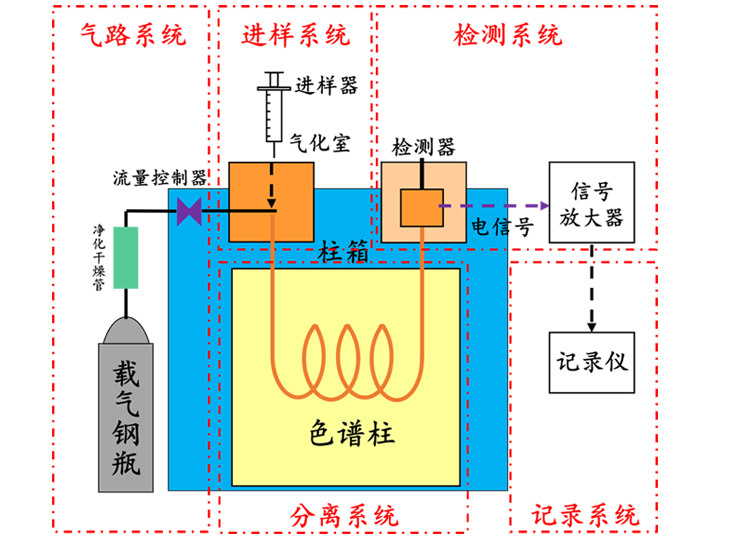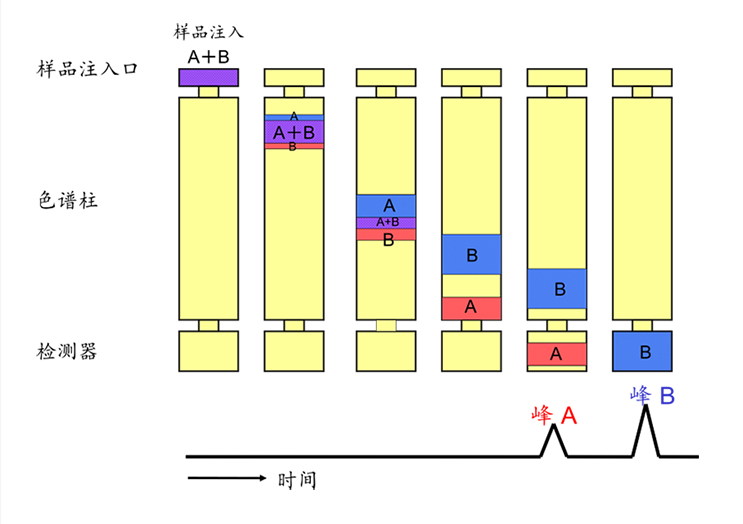1. Basic Principles of Gas Chromatography:
Chromatography, also known as chromatography or layering chromatography, is a physical-chemical separation method that utilizes the characteristics of substance solubility and adsorption. The separation principle is based on the differences in the interactions of various components in the mixture with the mobile phase and stationary phase.
Gas chromatography (GC), which uses gas as the mobile phase, is a highly automated chromatographic method widely used for the quantitative analysis of substances with small molecular weights and complex compositions.
Mobile phase: The fluid that carries the sample through the entire system, also known as the carrier gas.
Stationary phase: The immobile phase, which includes the support material, stationary liquid, or packing material inside the chromatographic column.
2. Components of a Gas Chromatograph:
Gas chromatograph consists mainly of the gas flow system, injection system, separation system, detection and temperature control system, and recording system.

Figure 1. Simplified Structure of a Gas Chromatograph
1. Gas Flow System of a Gas Chromatograph
The gas flow system of a gas chromatograph includes the gas source, purification and drying tube, and carrier gas flow rate control device. It is a closed pipeline system for continuous carrier gas operation, providing pure and stable carrier gas for the gas chromatograph. The gas tightness, accuracy of flow rate monitoring, and stability of carrier gas flow rate are all crucial factors affecting the performance of a gas chromatograph.
Commonly used carrier gases in gas chromatography include hydrogen, nitrogen, and argon, with a purity requirement of over 99.999%. These gases should be chemically inert and not react with the analytes. The choice of carrier gas depends not only on achieving optimal separation for the analytes but also on the sensitivity of the detector under different carrier gas conditions.
2. Injection System of a Gas Chromatograph
The injection system of a gas chromatograph mainly consists of a sampler and a vaporization chamber.
(1) Sampler: Different samplers are used depending on the physical state of the analytes. Liquid samples are typically injected using a micro-volume syringe, as shown in Figure 2. Gas samples are usually injected using the gas chromatograph's built-in rotary six-way valve or a micro-volume injector, as shown in Figure 2.

Figure 2. Gas and Liquid Sample Injectors
Solid samples are typically dissolved in a suitable solvent and then injected as a liquid.
(2) Vaporization Chamber: The vaporization chamber is usually made of stainless steel tubing with an external heating element. Its purpose is to instantaneously vaporize the liquid sample into vapor. The vaporization chamber should have a sufficiently large heat capacity and no catalytic effect to ensure that the sample is vaporized instantly without decomposition.
3. Separation System of a Gas Chromatograph
The separation system of a gas chromatograph is the core component responsible for separating the individual components of the sample.
The separation system consists of the column oven, chromatographic column, and temperature control components.
Chromatographic columns can be divided into two main types: packed columns and capillary columns. Column materials can include metals, glass, fused silica, and polytetrafluoroethylene (PTFE). The separation efficiency of a chromatographic column depends on factors such as column length, diameter, shape, packing material, and operating conditions.
4. Detection System of a Gas Chromatograph
The detection system of a gas chromatograph converts changes in the concentration or mass of the sample components into electrical signals, amplifies them, and records them on a recorder. The performance of the detector directly affects the accuracy of the chromatographic analysis.
Detectors can be classified into concentration-type detectors and mass-type detectors based on their response principles.
(1) Concentration-Type Detectors: These detectors measure the instantaneous concentration changes of analytes in the carrier gas. The detector response signal is proportional to the concentration of the analyte. Examples include the thermal conductivity detector (TCD) and the electron capture detector (ECD).
(2) Mass-Type Detectors: These detectors measure the rate at which analytes carried by the carrier gas enter the detector. The detector response signal is proportional to the mass of the analyte entering the detector per unit time. Examples include the flame ionization detector (FID) and the flame photometric detector (FPD).
5. Temperature Control System of a Gas Chromatograph
In a gas chromatograph, temperature control is crucial, as it directly affects the separation efficiency of the chromatographic column, detector sensitivity, and stability. The temperature control system primarily targets the vaporization chamber, chromatographic column, and detector.
The vaporization chamber must ensure the instantaneous vaporization of the liquid sample, while the chromatographic column should ensure complete separation of components. When there are numerous analyte components in the sample, the column temperature needs to be controlled by a program to achieve optimal separation, ensuring that all components pass through the detector without condensation.
The temperature control in a gas chromatograph can be classified into two modes: isothermal and programmed temperature rise.
(1) Isothermal Temperature Control: This mode is suitable for simple samples with a narrow boiling range. It is commonly used for gas analysis and liquid sample analysis.
(2) Programmed Temperature Rise: In this mode, the column temperature increases stepwise from low to high during a single analysis cycle. This approach helps improve separation for components with different boiling points, reducing analysis time. For complex samples with a wide boiling range, programmed temperature rise is preferred.
6. Recording System of a Gas Chromatograph
The recording system of a gas chromatograph is primarily used to record the detector's signals, perform quantitative data processing, and maintain records. Some gas chromatographs are equipped with electronic computers that can automatically measure the peak areas and provide accurate data for quantitative analysis. They can also automatically reprocess chromatographic analysis data.
Three. Analysis Process of a Gas Chromatograph
The carrier gas for the gas chromatograph flows out of a high-pressure steel cylinder and is reduced to the required pressure by a pressure-reducing valve. It then passes through a purification and drying tube to purify the carrier gas. After that, it goes through a pressure regulator and a flowmeter to flow through the vaporization chamber, where it mixes with the vaporized sample that has completed vaporization. The sample gas is then transported to the chromatographic column for separation. After separation, the individual components enter the detector for analysis.
The detector converts changes in the concentration or mass of the analyte into electrical signals, which are recorded on a recorder. The chromatographic flow curve can be obtained based on the retention times. Qualitative analysis can be performed based on the retention time, while quantitative analysis can be performed based on the peak area or height. The specific analysis process is shown in Figure 3.

Figure 3. Analysis Process of a Gas Chromatograph